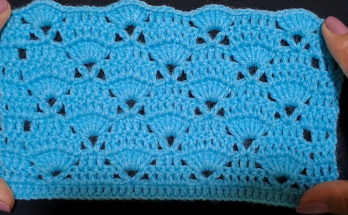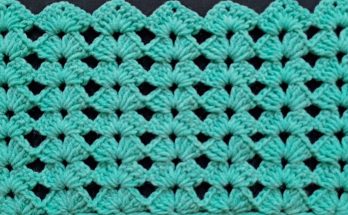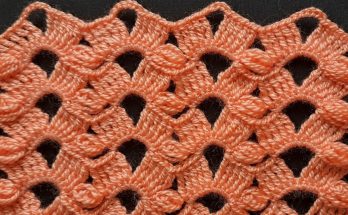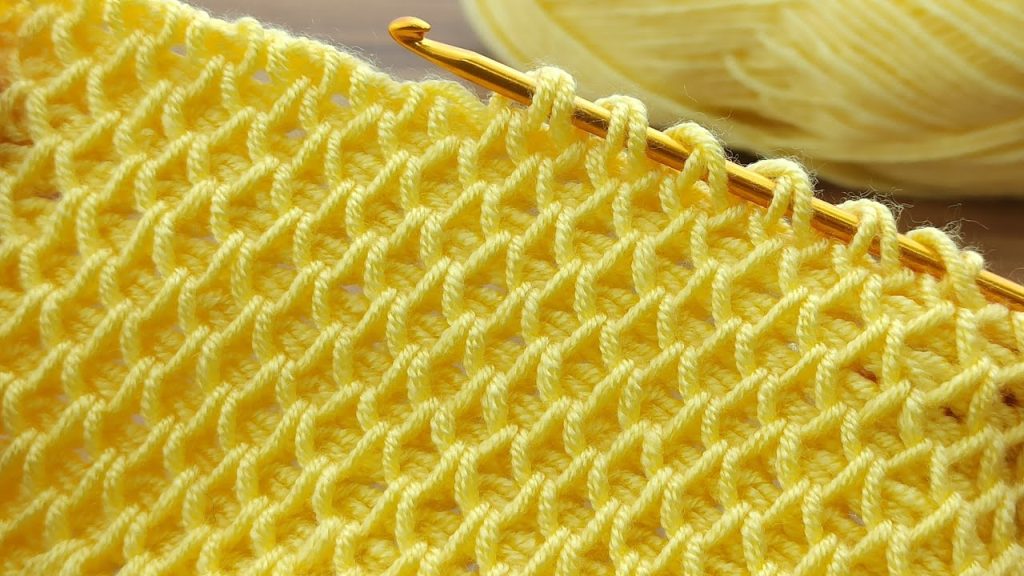
Welcome, dedicated Tunisian crocheters! Today, we are diving deep into a fabulous technique that creates a dense, basket-like weave with a beautiful diagonal slant. The Tunisian Diagonal Cross Stitch (TDCS) is a textural wonder, resulting in a fabric that is thick, reversible-looking, and wonderfully stable. It’s an excellent choice for structured projects like bags, pillows, or warm outerwear.
This pattern is a variation of the Tunisian Full Stitch (TFS), where the hook is inserted between the stitches, but with a slight diagonal pull to create the ‘X’ shape. The key, as with all Tunisian crochet, is the two-pass system: the Forward Pass (FwP) and the Return Pass (RetP).
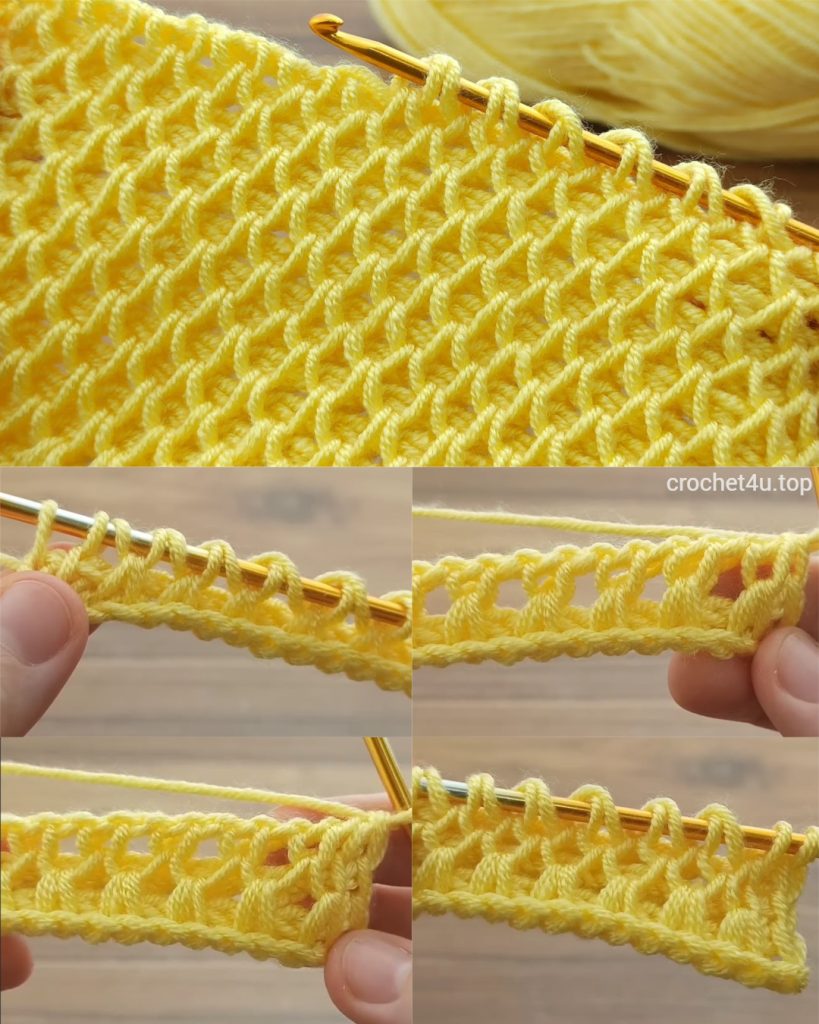
🛍️ Materials, Preparation, and Pro-Tips
Choosing Your Tools for Precision
- Hook: A Tunisian crochet hook (afghan hook) is absolutely mandatory. For large projects, ensure your hook has a cable to hold all your working loops.
- Hook Size: A 6.0 mm (J-10 US) to 7.0 mm (L-11 US) hook. For Tunisian crochet, always select a hook 1 to 2 sizes larger than the size recommended on your yarn label. This is essential to counteract the fabric’s natural tendency to curl and to give the dense stitches room to breathe.
- Yarn: A smooth Worsted Weight (Aran/10-ply) or DK Weight (8-ply) yarn works best. A light, solid color like the yellow shown will highlight the beautiful woven texture.
- Notions Checklist: Sharp Scissors, a Tapestry Needle, and a measuring tape to check gauge.
Gauge and Multiple
- Pattern Multiple: This specific version of the Diagonal Cross Stitch is worked over a multiple of 2 stitches, plus 1 for the foundation chain.
- Example Chain (for a swatch): Ch 27 (2 x 13 = 26, plus 1 = 27).
📌 Stitch Abbreviations & Technical Definitions (Tunisian Terms)
Core Stitches
- ch: Chain
- st(s): Stitch(es)
- Tss: Tunisian Simple Stitch
- TDCS: Tunisian Diagonal Cross Stitch (Our special stitch)
- FwP: Forward Pass
- RetP: Return Pass
- yo: Yarn Over
- Lp: Loop
Key Tunisian Components
- Last Stitch (Edge St): Always worked under both the front and back vertical bars of the last stitch of the previous row. This creates a sturdy, professional edge that minimizes curl.
The Key Stitch: Tunisian Diagonal Cross Stitch (TDCS)
The TDCS is similar to the Tunisian Full Stitch (TFS) but worked with a consistent directional pull.
TDCS Definition (Worked in the FwP):
- Skip the first vertical bar (this is the loop already on the hook).
- Insert hook into the space between the first and second vertical bars, angling the hook slightly to the left (or right, if you are a lefty).
- Yo, pull up a loop, extending it to the height of the row.
- Insert hook into the space between the second and third vertical bars, angling the hook in the same direction.
- Yo, pull up a loop, extending it to the height of the row.
- Continue this method across the row, always picking up loops in the spaces between the vertical bars.
➡️ Phase 1: The Foundation and Setup
The foundation sets up the basic grid of stitches for the dense texture.

Row 1: Foundation Row (Tss)
- Ch the required number (e.g., Ch 27).
- FwP: Insert hook into the 2nd ch from the hook, yo, pull up a loop. Keep the loop on the hook. Repeat across the row, inserting the hook into the back bump of each chain. (You should have 27 loops on your hook).
- RetP: Yo, pull through 1 loop. *Yo, pull through 2 loops.* Repeat from * to * until only 1 loop remains on the hook.
☀️ Phase 2: Creating the Diagonal Cross Texture
This two-row repeat forms the entire woven structure.

Row 2: First TDCS Forward Pass (Creating the Crosses)
- FwP:
- Skip the first vertical bar (the loop on the hook counts as the first stitch).
- Work the TDCS across the row: Insert hook into the space between the first and second vertical bar, yo, pull up a loop.
- Continue inserting the hook into the spaces between the vertical bars all the way across the row.
- Work the Last Stitch under both vertical bars. (You should have 27 loops on your hook).
- RetP: Yo, pull through 1 loop. *Yo, pull through 2 loops.* Repeat from * to * until only 1 loop remains on the hook.

Row 3: Second TDCS Forward Pass (Locking the Texture)
This row is worked identically to Row 2, inserting the hook into the spaces created by the previous row’s RetP.
- FwP:
- Skip the first vertical bar.
- Work the TDCS across the row, inserting the hook into the spaces between the vertical bars created by Row 2.
- Work the Last Stitch under both vertical bars. (You should have 27 loops on your hook).
- RetP: Yo, pull through 1 loop. *Yo, pull through 2 loops.* Repeat from * to * until only 1 loop remains on the hook.
🔁 Phase 3: The Complete Pattern Repeat
The density and texture of the Tunisian Diagonal Cross Stitch are achieved by simply repeating Row 3.
- Repeat Row: Repeat Row 3 (TDCS FwP followed by RetP) until your piece reaches the desired length.

Advanced Scaling: Troubleshooting Curl and Slant
- Minimizing Curl (FwP): Since this stitch is worked in the spaces, the fabric may want to curl more than basic Tss. Be meticulous about using your oversized hook and keep your tension loose on the pulled-up loops, especially at the edges.
- Managing Slant (Blocking): This texture naturally creates a slight diagonal slant. Wet blocking is mandatory for this stitch. Pin the fabric firmly to a blocking mat, ensuring all edges are perfectly straight and square. The density of the fabric will hold the shape once blocked.
Video Tutorial:
✂️ Finishing and Structural Integrity
Binding Off (Creating a Final Edge)
A final Bind Off row is essential for stability and to prevent unraveling.
- FwP (Bind Off): Work the Forward Pass exactly as you have been (TDCS into the spaces).
- However, when you pull up the second loop, you will immediately sl st through the loop already on the hook (instead of leaving the new loop on the hook). This creates a simple slip stitch bind-off that mimics the ribbing.
- Continue this method (TDCS, then immediately bind off with a sl st) until the last stitch.
- Fasten off and weave in the end.
Fabric Characteristics
The finished fabric is extremely dense, thick, and highly reversible. It has virtually no stretch but excellent structural integrity, making it a professional-grade textile.
This Tunisian Diagonal Cross Stitch creates a warm, intricate, and stable material. Enjoy the fantastic texture!

